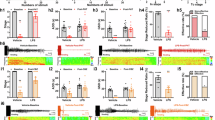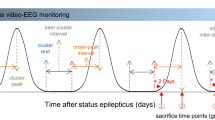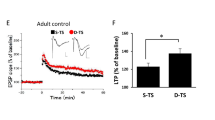Abstract
Cholinergic transmission, independent of classical glutamatergic and GABAergic signaling, critically plays a crucial role in epilepsy. Huperzine A (Hup A), an acetylcholinesterase (AChE) inhibitor, exerts potent anticonvulsant activity, but its mechanism of action within cholinergic circuits remains unclear. Here, we show that Hup A mitigates epileptic seizures by enhancing hippocampal dorsal CA1 (dCA1)-projecting cholinergic transmission. We found that systemic injection of Hup A not only reduces seizures in acute models, including the maximal-electroshock seizure (MES), pentylenetetrazol (PTZ), and kainic acid (KA) models but also alleviates the seizure severity in chronic epilepsy models induced by kindling and KA, indicating a broad-spectrum anti-seizure efficacy. Interestingly, using immunohistochemistry, viral tracing, and in vivo fiber photometry, we found that Hup A selectively inhibits AChE in the dCA1 rather than in other hippocampal subregions or cortex, enhancing dCA1-projecting septal cholinergic transmission. Significantly, selective ablation of septal ChAT+ neurons reversed the anti-seizure effects of Hup A. We further identified that α7 nicotinic acetylcholine receptors in the dCA1 region mediate the anti-seizures cholinergic circuit modulated by Hup A. Together, our results demonstrate that Hup A exerts broad-spectrum anti-seizure efficacy via modulating dCA1-projecting septal cholinergic transmission, providing potential therapeutic avenues for epilepsy through targeted cholinergic modulation.
This is a preview of subscription content, access via your institution
Access options
Subscribe to this journal
Receive 12 print issues and online access
$259.00 per year
only $21.58 per issue
Buy this article
- Purchase on SpringerLink
- Instant access to full article PDF
Prices may be subject to local taxes which are calculated during checkout






Similar content being viewed by others
Data availability
The data that support the findings of this study are available from the corresponding author upon reasonable request.
References
Thijs RD, Surges R, O’Brien TJ, Sander JW. Epilepsy in adults. Lancet. 2019;393:689–701.
Klein P, Kaminski RM, Koepp M, Löscher W. New epilepsy therapies in development. Nat Rev Drug Discov. 2024;23:682–708.
Xu C, Gong Y, Wang Y, Chen Z. New advances in pharmacoresistant epilepsy towards precise management-from prognosis to treatments. Pharmacol Ther. 2022;233:108026.
Rafii MS, Walsh S, Little JT, Behan K, Reynolds B, Ward C, et al. A phase II trial of huperzine A in mild to moderate Alzheimer disease. Neurology. 2011;76:1389–94.
Bialer M, Johannessen SI, Koepp MJ, Levy RH, Perucca E, Tomson T, et al. Progress report on new antiepileptic drugs: a summary of the Fourteenth Eilat Conference on New Antiepileptic Drugs and Devices (EILAT XIV). I. Drugs in preclinical and early clinical development. Epilepsia. 2018;59:1811–41.
Mohseni-Moghaddam P, Sadr SS, Roghani M, Arabzadeh S, Khamse S, Zamani E, et al. Huperzine A ameliorates cognitive dysfunction and neuroinflammation in kainic acid-induced epileptic rats by antioxidant activity and NLRP3/caspase-1 pathway inhibition. Clin Exp Pharmacol Physiol. 2019;46:360–72.
Wong JC, Dutton SB, Collins SD, Schachter S, Escayg A. Huperzine A provides robust and sustained protection against induced seizures in Scn1a mutant mice. Front Pharmacol. 2016;7:357.
Wong JC, Grieco SF, Dutt K, Chen L, Thelin JT, Inglis GAS, et al. Autistic-like behavior, spontaneous seizures, and increased neuronal excitability in a Scn8a mouse model. Neuropsychopharmacology. 2021;46:2011–20.
Dinday MT, Baraban SC. Large-scale phenotype-based antiepileptic drug screening in a zebrafish model of dravet syndrome. eNeuro. 2015;2:ENEURO.0068-0015.
Curia G, Longo D, Biagini G, Jones RS, Avoli M. The pilocarpine model of temporal lobe epilepsy. J Neurosci Methods. 2008;172:143–57.
Foster FM. Action of acetylcholine on motor cortex; correlation of effects of acetylcholine and epilepsy. Arch Neurol Psychiatry. 1945;54:391–4.
Ferencz I, Leanza G, Nanobashvili A, Kokaia M, Lindvall O. Basal forebrain neurons suppress amygdala kindling via cortical but not hippocampal cholinergic projections. Eur J Neurosci. 2000;12:2107–16.
Andrews JP, Yue Z, Ryu JH, Neske G, McCormick DA, Blumenfeld H. Mechanisms of decreased cholinergic arousal in focal seizures: in vivo whole-cell recordings from the pedunculopontine tegmental nucleus. Exp Neurol. 2019;314:74–81.
Wang Y, Wang Y, Xu C, Wang S, Tan N, Chen C, et al. Direct septum-hippocampus cholinergic circuit attenuates seizure through driving somatostatin inhibition. Biol Psychiatry. 2020;87:843–56.
Wang Y, Shen Y, Cai X, Yu J, Chen C, Tan B, et al. Deep brain stimulation in the medial septum attenuates temporal lobe epilepsy via entrainment of hippocampal theta rhythm. CNS Neurosci Ther. 2021;27:577–86.
Zheng Y, Xu C, Sun J, Ming W, Dai S, Shao Y, et al. Excitatory somatostatin interneurons in the dentate gyrus drive a widespread seizure network in cortical dysplasia. Signal Transduct Target Ther. 2023;8:186.
Wang Y, Qiu XY, Liu JY, Tan B, Wang F, Sun MJ, et al. (+)-Borneol enantiomer ameliorates epileptic seizure via decreasing the excitability of glutamatergic transmission. Acta Pharmacol Sin. 2023;44:1600–11.
Tang Y, Feng B, Wang Y, Sun H, You Y, Yu J, et al. Structure-based discovery of CZL80, a caspase-1 inhibitor with therapeutic potential for febrile seizures and later enhanced epileptogenic susceptibility. Br J Pharmacol. 2020;177:3519–34.
Wang Y, Xu C, Xu Z, Ji C, Liang J, Wang Y, et al. Depolarized GABAergic signaling in subicular microcircuits mediates generalized seizure in temporal lobe epilepsy. Neuron. 2017;95:92–105.e105.
Fei F, Wang X, Xu C, Shi J, Gong Y, Cheng H, et al. Discrete subicular circuits control generalization of hippocampal seizures. Nat Commun. 2022;13:5010.
Zhao J, Sun J, Zheng Y, Zheng Y, Shao Y, Li Y, et al. Activated astrocytes attenuate neocortical seizures in rodent models through driving Na+-K+-ATPase. Nat Commun. 2022;13:7136.
Loscher W. Critical review of current animal models of seizures and epilepsy used in the discovery and development of new antiepileptic drugs. Seizure. 2011;20:359–68.
Loscher W. Animal models of seizures and epilepsy: past, present, and future role for the discovery of antiseizure drugs. Neurochem Res. 2017;42:1873–88.
Tang XC, De Sarno P, Sugaya K, Giacobini E. Effect of huperzine A, a new cholinesterase inhibitor, on the central cholinergic system of the rat. J Neurosci Res. 1989;24:276–85.
Tervo DG, Hwang BY, Viswanathan S, Gaj T, Lavzin M, Ritola KD, et al. A designer AAV variant permits efficient retrograde access to projection neurons. Neuron. 2016;92:372–82.
Jing M, Li Y, Zeng J, Huang P, Skirzewski M, Kljakic O, et al. An optimized acetylcholine sensor for monitoring in vivo cholinergic activity. Nat Methods. 2020;17:1139–46.
Yang C, Chiang M, Gray D, Prabhakaran M, Alvarado M, Juntti S, et al. Sexually dimorphic neurons in the ventromedial hypothalamus govern mating in both sexes and aggression in males. Cell. 2013;153:896–909.
Fan Z, Chang J, Liang Y, Zhu H, Zhang C, Zheng D, et al. Neural mechanism underlying depressive-like state associated with social status loss. Cell. 2023;186:560–576 e517.
Letsinger AC, Gu Z, Yakel JL. α7 nicotinic acetylcholine receptors in the hippocampal circuit: taming complexity. Trends Neurosci. 2022;45:145–57.
Becchetti A, Grandi LC, Cerina M, Amadeo A. Nicotinic acetylcholine receptors and epilepsy. Pharmacol Res. 2023;189:106698.
White HS, Johnson M, Wolf HH, Kupferberg HJ. The early identification of anticonvulsant activity: role of the maximal electroshock and subcutaneous pentylenetetrazol seizure models. Ital J Neuro Sci. 1995;16:73–77.
Gersner R, Ekstein D, Dhamne SC, Schachter SC, Rotenberg A. Huperzine A prophylaxis against pentylenetetrazole-induced seizures in rats is associated with increased cortical inhibition. Epilepsy Res. 2015;117:97–103.
White HS, Schachter S, Lee D, Xiaoshen J, Eisenberg D. Anticonvulsant activity of Huperzine A, an alkaloid extractof Chinese club moss (Huperzia serrata). Epilepsia. 2005;46(Suppl. 8):220.
Bialer M, Johannessen SI, Levy RH, Perucca E, Tomson T, White HS. Progress report on new antiepileptic drugs: a summary of the Twelfth Eilat Conference (EILAT XII). Epilepsy Res. 2015;111:85–141.
Gordon RK, Nigam SV, Weitz JA, Dave JR, Doctor BP, Ved HS. The NMDA receptor ion channel: a site for binding of huperzine A. J Appl Toxicol. 2001;21:S47–S51.
McKinney M, Miller JH, Yamada F, Tuckmantel W, Kozikowski AP. Potencies and stereoselectivities of enantiomers of huperzine A for inhibition of rat cortical acetylcholinesterase. Eur J Pharmacol. 1991;203:303–5.
Zimmerman G, Njunting M, Ivens S, Tolner EA, Behrens CJ, Gross M, et al. Acetylcholine-induced seizure-like activity and modified cholinergic gene expression in chronically epileptic rats. Eur J Neurosci. 2008;27:965–75.
Tang XC, Han YF. Pharmacological profile of Huperzine A, a novel acetylcholinesterase inhibitor from chinese herb. CNS Drug Rev. 1999;5:281–300.
Forcelli PA. Septal signaling suppresses seizures through stimulating somatostatin cells. Epilepsy Curr. 2020;20:297–9.
Séguéla P, Wadiche J, Dineley-Miller K, Dani JA, Patrick JW. Molecular cloning, functional properties, and distribution of rat brain alpha 7: a nicotinic cation channel highly permeable to calcium. J Neurosci. 1993;13:596–604.
Buhler AV, Dunwiddie TV. alpha7 nicotinic acetylcholine receptors on GABAergic interneurons evoke dendritic and somatic inhibition of hippocampal neurons. J Neurophysiol. 2002;87:548–57.
Kawa K. Inhibitory synaptic transmission in area postrema neurons of the rat showing robust presynaptic facilitation mediated by nicotinic ACh receptors. Brain Res. 2007;1130:83–94.
Ishibashi M, Yamazaki Y, Miledi R, Sumikawa K. Nicotinic and muscarinic agonists and acetylcholinesterase inhibitors stimulate a common pathway to enhance GluN2B-NMDAR responses. Proc Natl Acad Sci USA. 2014;111:12538–43.
Acknowledgments
This project was supported by grants from the National Natural Science Foundation of China (82373859, 82330116, 82404590, and 82401698), the Natural Science Foundation of Zhejiang Province (LD24H310001 and LD22H310003), and the Postdoctoral Science Foundation of China (2023M743144).
Author information
Authors and Affiliations
Contributions
The main idea of this study was from Yi W, ZC, and Yu W. Yu W, KYH, QYZ, YJS, LJL, and FW conducted the experiments. Yu W, KYH, and QYZ conducted the data analysis. GT, FF, CLX, JJF, XHJ, and JNW provided technical guidance and contributed to the data discussion. Yu W and Yi W wrote the manuscript. WLL and Yi W edited the manuscript. Yi W and ZC supervised all aspects of the work.
Corresponding authors
Ethics declarations
Competing interests
The authors declare no competing interests.
Additional information
Publisher’s note Springer Nature remains neutral with regard to jurisdictional claims in published maps and institutional affiliations.
Supplementary information
Rights and permissions
Springer Nature or its licensor (e.g. a society or other partner) holds exclusive rights to this article under a publishing agreement with the author(s) or other rightsholder(s); author self-archiving of the accepted manuscript version of this article is solely governed by the terms of such publishing agreement and applicable law.
About this article
Cite this article
Wang, Y., Hu, Ky., Zhang, Qy. et al. Huperzine A attenuates epileptic seizures via enhancing dCA1-projecting septal cholinergic transmission. Acta Pharmacol Sin 46, 2151–2162 (2025). https://doi.org/10.1038/s41401-025-01522-w
Received:
Accepted:
Published:
Issue date:
DOI: https://doi.org/10.1038/s41401-025-01522-w



